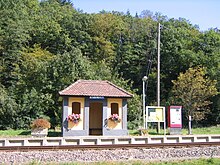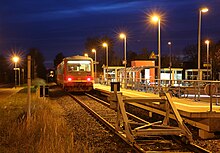Breakpoint




A breakpoint (abbreviation: Hp ) is in Germany a railway system where passengers trains can climb or leave, which is a point of access for travelers.
The difference to the station is that at breakpoints only switched on and got out at stations but ranks can be. Furthermore, a stop normally has no turnouts , unless it is locally connected to another operating point .
The exact definition depends on national legal and operational regulations, which is why stopping points are usually classified as less important access points, which are often structurally poorly accessible to travelers .
Definition according to EBO
The railway building and operating regulations define in § 4:
- Breakpoint
- "Stopping points are railway systems without switches, where trains are allowed to stop, start or end as planned." (Section 4, Paragraph 8)
- bus stop
- "Stops are branch points or connection points that are locally connected to a stopping point." (Section 4, Paragraph 9)
Comparable railway systems are generally referred to as stops in Austria , Switzerland and South Tyrol .
History
The stop was introduced by the railway building and operating regulations and a new driving service regulation in Germany at the Deutsche Reichsbahn in 1933 and given the official abbreviation "Hst".
Operational facilities
In terms of rail operations, a stop only has the function of an access point for passenger traffic, i.e. it only offers the possibility of getting on and off trains. In contrast to a train station, trains can only stop there and in some cases also turn around, but not overtake or cross each other .
A stop consists of one or more platforms , which are arranged on the individual tracks of the open route with entrances and exits. In some areas, instead of a platform, there may only be an unpaved boarding option.
Many of today's stops used to be train stations with overtaking and siding , which were then abandoned or dismantled. Typical examples of this are the former Hamburg Dammtor train station or Gevelsberg Hauptbahnhof , both of which are only stops in operational terms.
Some train stations - for example Mülheim (Ruhr) Hauptbahnhof - differ from a stopping point by a single pair of switches.
The stops now also include many endpoints of branch lines where the only track without a switch connection ends and can only be turned, e.g. B. Waging and Oberammergau .
No signals are usually set up at a breakpoint . If the stopping point is not clearly visible due to the local conditions, a stopping point board (Ne 6) is set up at the braking distance. If there is a platform between a pre- signal and a main signal - this is usually a block signal - the pre- signal is repeated at the end of the platform with a pre-signal repeater . In the case of a stop, the signals belonging to the branch point can be set up in the area of the stop.
Demand breakpoint
A special form of the breakpoint is the demand breakpoint . Trains only stop at them when passengers actually want to get on or off. There are stop request buttons on the train, which passengers who want to get off at the request stop must press in good time.
Some demand stops have a switch on the platform with which passengers who want to board can signal the corresponding demand to the approaching train in good time. This is available, for example, at some new stops on the Hohenzollerische Landesbahn .
However, on many routes there are no special technical signaling devices on the platform. There it is necessary for passengers to be aware of the approaching train so that it stops.
When even the smallest stations were staffed, passengers who wanted to get on a train had to report to the supervisory officer at the stop, and passengers who got off had to inform the conductor or train driver of their request at least one stop in advance.
Individual evidence
- ↑ § 4 Explanation of terms. In: Railway Building and Operating Regulations (EBO). Federal Ministry of Justice and Consumer Protection, September 28, 1955, accessed on February 6, 2017 .
- ↑ Deutsche Reichsbahn-Gesellschaft (Ed.): Official Gazette of the Reichsbahndirektion Mainz of September 9, 1933, No. 41. Announcement No. 482, p. 181.
